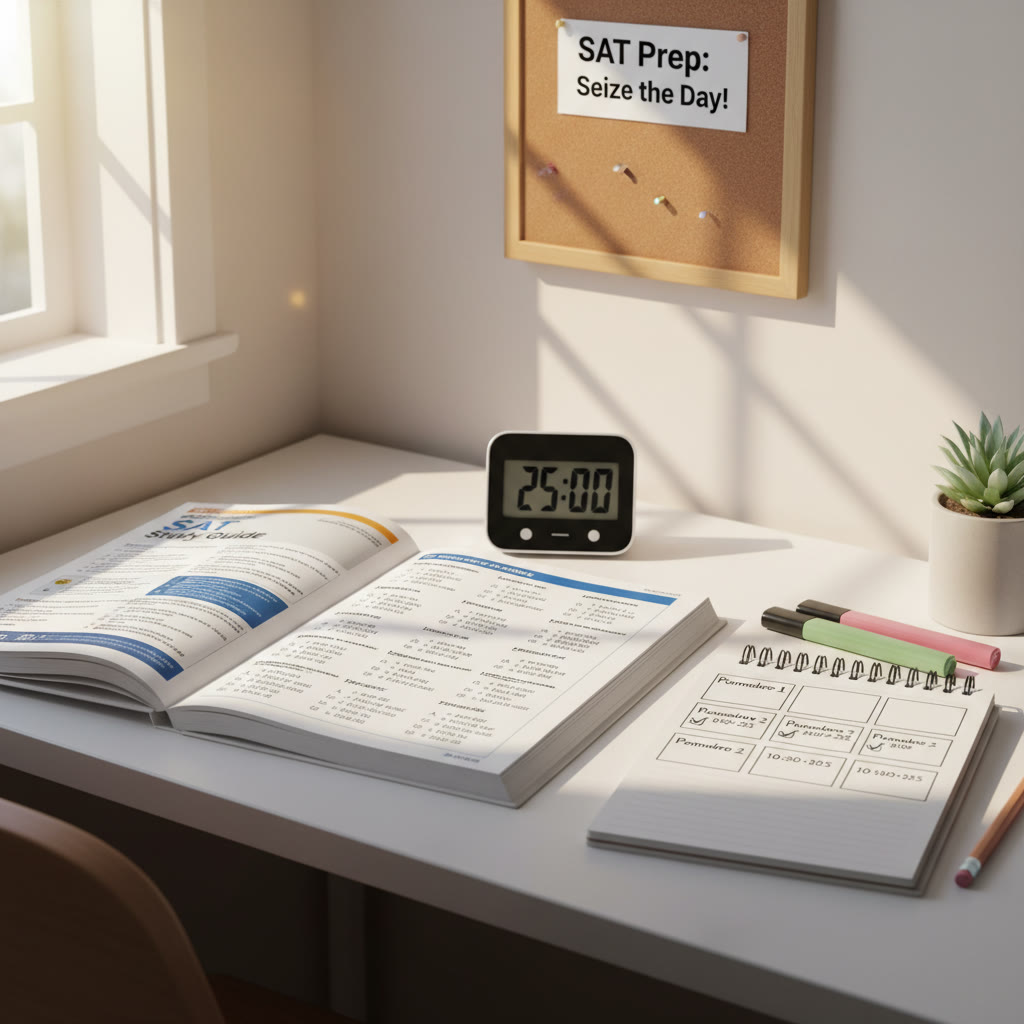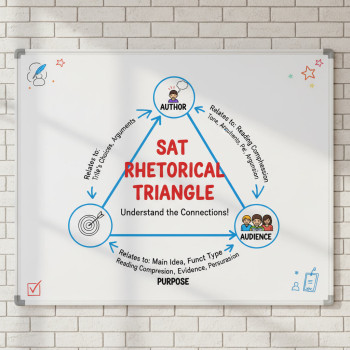Why the Pomodoro Technique is a Secret Weapon for SAT Prep
If you picture yourself buried under a pile of practice questions, notebooks, and motivational quotes on sticky notes, the Pomodoro Technique is the calm, steady timer that brings structure to the chaos. It’s simple: short, intense bursts of focused work followed by brief breaks. For SAT prep, where stamina, concentration, and retention matter more than cramming, Pomodoro offers a practical rhythm that trains both your brain and your schedule.
This post will walk you through exactly how to use Pomodoro for SAT study—realistic session plans, weekly templates, strategies for the Reading, Writing and Language, Math, and Essay portions, and ways to combine Pomodoro with active recall, practice tests, and Sparkl’s personalized tutoring and benefits when you want one-on-one guidance or a tailored study plan.
Pomodoro Basics (The Rules, But Friendly)
Francesco Cirillo’s original Pomodoro method is gloriously uncomplicated. You:
- Pick a task.
- Work for 25 minutes (1 Pomodoro).
- Take a 5-minute break.
- Repeat. After four Pomodoros, take a longer break (15–30 minutes).
That structure is a fantastic starting point, but it’s not gospel. For SAT prep you can tweak the lengths, cluster related tasks, and combine Pomodoros into focused blocks that mimic test conditions or target specific skill areas.
Why Pomodoro Works for SAT Prep
- Prevents burnout: Short bursts reduce decision fatigue. You don’t have to psych yourself up for an all-day marathon—just 25 minutes at a time.
- Builds consistent focus: Training attention in small, repeatable units transfers to longer test sections.
- Encourages deliberate practice: You can assign each Pomodoro to one specific skill—data interpretation, grammar rules, or algebra practice—and measure progress.
- Makes review manageable: Breaks let you process mistakes and reset your memory before the next round.
Customizing Pomodoro for SAT Sections
Each SAT section has different demands. Here’s how to tailor Pomodoros so each 25-minute burst maps to useful practice.
Reading Section
Goal: build comprehension speed and evidence-based analysis.
- Pomodoro 1: Read 1 passage carefully, annotate structure and tone.
- Pomodoro 2: Answer 5-7 questions, focusing on evidence-based answers.
- Pomodoro 3: Review mistakes and note patterns (inferential vs. detail questions).
You can stretch to 35–45 minute Pomodoros for full passages if you’re simulating timed sets.
Writing and Language
Goal: spot grammar patterns and sharpen rhetorical skills.
- Pomodoro 1: Drill grammar rules (subject-verb agreement, punctuation) through targeted exercises.
- Pomodoro 2: Work on passage-level questions in sets of 8–12.
- Pomodoro 3: Practice editing for clarity and concision; track recurring error types.
Math—No Calculator and Calculator
Goal: strengthen procedural fluency and smart problem selection.
- Pomodoro 1: Speed drills (mental math, algebra manipulations) for 20–25 minutes.
- Pomodoro 2: Focused problem set on a single topic (functions, geometry).
- Pomodoro 3: Error review and technique adjustment (e.g., diagram strategies).
Essay (If You’re Taking It)
Goal: craft thesis-driven, evidence-based analyses under time pressure.
- Pomodoro 1: Outline practice (5–7 minutes to outline, remainder to draft intro and first body paragraph).
- Pomodoro 2: Finish draft and refine language, focusing on clarity and evidence integration.
- Pomodoro 3: Timed essay simulations—shorten or lengthen Pomodoros to match the real test time.
Sample Daily Pomodoro Schedule for a High-Impact Study Day
Below is a sample schedule that balances skills, practice tests, and review. Use it as a template and adjust durations based on your energy level and time constraints.
| Time | Activity | Pomodoro Blocks | Purpose |
|---|---|---|---|
| 8:30–9:30 AM | Warm-up: Reading comprehension drills | 2 (25 + 25) | Build morning focus |
| 9:45–11:00 AM | Math topic practice (quadratics) | 3 (25 + 25 + 25) | Deliberate practice |
| 11:30–12:30 PM | Writing and Language exercises | 2 (25 + 25) | Grammar and clarity |
| 1:30–3:30 PM | Full diagnostic section (Reading or Math) | 4–6 (35–45 min each) | Simulated test stamina |
| 4:00–5:00 PM | Review mistakes and plan next steps | 2 (25 + 25) | Active error correction |
Note: Longer Pomodoros (35–45 minutes) are ideal when you want to mimic the actual SAT timing and stamina requirements. The important thing is consistency: frequent focused practice beats unpredictable, unfocused hours.
Weekly Plan: How to Rotate Skills Without Burning Out
A weekly plan prevents undertraining of weaker areas while keeping strong areas sharp. Here’s a flexible 6-day plan where Sunday is a rest or light review day.
- Monday: Reading focus (comprehension drills + timed passages)
- Tuesday: Math (concepts + timed problem sets)
- Wednesday: Writing and Language + grammar drills
- Thursday: Mixed practice (sections back-to-back using extended Pomodoros)
- Friday: Targeted weakness work (tutor session or focused drills)
- Saturday: Full practice test (simulate test day with breaks) and thorough review
That Friday slot is a great time to incorporate Sparkl’s personalized tutoring and benefits: a one-on-one session can identify specific weaknesses, produce a tailored study plan, and provide AI-driven insights on your error patterns. Then use the weekend to act on that feedback with Pomodoro-driven practice.
How to Design Pomodoros for Active Learning
You get the most from Pomodoro when each block has an explicit purpose and a measurable output. Swap passive review for active tasks:
- Instead of ‘read chapter,’ try ‘summarize the chapter in five bullet points.’
- Replace ‘do practice problems’ with ‘complete 12 problems and write one-sentence error rationales for each incorrect answer.’
- Turn breaks into strategic resets: quick walks, breathing exercises, or a 5-minute stretch routine to get blood flowing.
Tracking Progress: Small Data, Big Wins
Keep a simple log after each Pomodoro. Track:
- Task attempted
- Number of correct vs. incorrect
- Mistake type
- Energy/focus rating (1–5)
Recording small pieces of data will reveal patterns. Maybe your accuracy dips in Math after three Pomodoros—that’s a signal to build stamina or split sessions differently. Sparkl’s AI-driven insights can automate pattern detection if you prefer an advanced dashboard; combined with tutor feedback, those insights translate into targeted Pomodoros and faster improvement.
Combining Pomodoro with Practice Tests
Full-length practice tests are non-negotiable. Use Pomodoro around them to manage preparation and post-test review.
- Before the test: Do 2–3 short Pomodoros for a warm-up—one reading and one math—so your brain is in study mode.
- During the test: You can’t use a timer every 25 minutes, but you can mimic the discipline by setting micro-goals for each section (e.g., finish passage 1 in 12 minutes).
- After the test: Use Pomodoro blocks for targeted review—25 minutes to categorize errors, 25 minutes to drill the most frequent mistake types, and 25 minutes to create a mini-plan for the next week.
When to Use Longer Pomodoros (and When Not To)
The 25/5 split is classic, but there are times when longer, focused intervals are preferable:
- Simulating real SAT sections: Use 35–50 minute Pomodoros.
- Deep learning sessions: When working through a complicated math concept, a 50-minute session with a 10-minute break can be more productive.
- Test stamina training: Build up gradually—start with two 35-minute sessions and add one every few weeks.
However, stick to shorter intervals if you notice your attention fades quickly. The utility of Pomodoro is in finding the sweet spot where focus is high and recovery is fast.
Troubleshooting Common Pomodoro Problems
Problem: My mind wanders halfway through a Pomodoro
Solution: Break the task into smaller, concrete sub-tasks. Instead of ‘study algebra,’ try ‘complete 6 quadratic practice problems and write one-line explanations for each.’ Also try the ‘two-minute rule’—if a distraction can be handled in under two minutes, do it during the break; otherwise jot it down and continue.
Problem: I keep skipping breaks and burning out
Solution: Set an actual alarm for breaks and honor them like appointments. Use breaks to move—standing, walking, hydrating. Consider pairing a study session with a reward system: five Pomodoros earns a longer break or a small treat.
Problem: I can’t simulate test timing accurately
Solution: Reserve at least one day every week for extended Pomodoro sessions that match section lengths. For example, the Reading section can be practiced as three 35–45 minute sessions covering multiple passages to build endurance.
Example: One Student’s Week Using Pomodoro to Raise a 1200 to 1400
Meet Alex (fictional, but believable). Starting SAT score: 1200. Target: 1400 in 3 months. Alex works 10–12 Pomodoro blocks per study day, focused on weak spots identified by Sparkl’s personalized tutoring session.
- Week 1–2: Diagnostic, tutor session, baseline Pomodoros for all sections.
- Weeks 3–8: Focused Pomodoros—math mechanics in the morning, reading strategies in the afternoon, weekly full practice test Saturday.
- Weeks 9–12: Stamina blocks—longer Pomodoros and timed sets. Final two weeks taper to review and targeted error correction.
Using this rhythm, Alex improves accuracy on algebra questions and reduces careless reading errors. The combination of Pomodoro discipline and personalized feedback from Sparkl—expert tutors, tailored study plans, and AI-driven insights—helps Alex move confidently toward the 1400 target without last-minute panic.
Tools and Apps That Complement Pomodoro
You don’t need anything fancy. A simple kitchen timer works. If you like apps, look for ones that let you customize interval lengths, track completed Pomodoros, and log notes. If you’re using tutoring services, ask your tutor to recommend a Pomodoro-friendly schedule tailored to your weak areas. Sparkl’s tutors often incorporate Pomodoro blocks into tailored study plans because they fit well with one-on-one guidance and progress tracking.
Final Checklist Before You Start a Pomodoro Day
- Define 3–5 clear objectives for the day.
- Set up a dedicated, distraction-minimized study space.
- Prepare materials in advance: practice tests, notebooks, pens, formula sheets.
- Decide on Pomodoro length (classic 25/5 or extended 35/10) and commit to a number of blocks.
- Schedule a debrief: 30 minutes at the end of the day to log errors and plan the next session.
Image Ideas


Parting Thought: Make Pomodoro Your Study Rhythm, Not Your Taskmaster
The Pomodoro Technique isn’t a rigid rulebook. It’s a habit scaffold—one that can turn scattered practice into steady progress. Use it to protect your focus, measure tiny improvements, and make consistent, low-stress progress toward your SAT goals.
And remember: the best study plan is the one you can stick to. If you want a partner to help translate your mock-test mistakes into a concrete Pomodoro calendar, Sparkl’s personalized tutoring and benefits—1-on-1 guidance, tailored study plans, expert tutors, and AI-driven insights—are designed to fit naturally into a focused routine. With structure, feedback, and a little creativity, your study blocks become stepping stones to test-day confidence.
Start small, track what matters, adjust with honesty, and celebrate the wins—every completed Pomodoro is momentum gained. Good luck, and study smart.















No Comments
Leave a comment Cancel